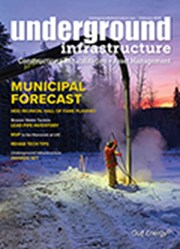June 2012, Vol. 67 No. 6
Features
Replacing Water Mains Through The Middle Of The University Of Nebraska

Following the establishment of the University of Nebraska in 1869, its Lincoln campus was laid out on four city blocks. University Hall, its first building, was an imposing structure standing on the prairie, well away from the city’s center.
The campus rapidly expanded to accommodate the university’s growing role in education, and today’s Lincoln campus covers 624 acres, blending historic structures with modern buildings in a beautifully-landscaped setting.
Campus improvements seem to be continually under way, always with the concern that damage to the campus streets, landscaping and disruption of university activities be minimized.
A recent water improvement program had the potential of being extremely disruptive.
“It was necessary to replace old water mains through the UNL city campus to improve service for existing and future water needs of the university’s main campus and provide better maintenance access to the underground mains,” said Terry McArthur, P.E. senior professional associate of the national engineering firm HDR, engineers for the project. The Lincoln Water System was the project owner. Primary contractor K2 Construction made the directional drilling installations.
The route of the new pipe was through the middle of the campus with extensive surface improvements, including landscaped areas and green spaces with sidewalk corridors, some containing large trees, area lighting, brick walks and streets and a parking lot. Landmarks in or near the construction area were the “Walk of Champions” sidewalk, a full-size statue of a mammoth in front of the university’s Museum of Natural History and sports facilities, including Memorial Stadium, home of the Cornhuskers football team.
The university was concerned about disturbing the existing improvements, said McArthur. In addition, beneath these improvements were many buried utilities.
Multiple obstacles
Subsurface obstacles included the old water main and services, gas mains and services, sanitary sewer mains, chilled water lines, communication and power cables, and steam tunnels. Establishing the location of these facilities required extensive subsurface utility engineering during the design.
The design process was performed as a collaborative effort among HDR, Lincoln Water, Lincoln Public Works and the University of Nebraska.
“The project was designed and bid documents completed in three months,” McArthur said. “Coordination meetings were held weekly during design and even daily during construction.”
Construction took an additional three months. Time was critical for this work as the improvements had to be completed prior to the beginning of a Special Olympics event.
Specifications required directional drilling at eight locations for segments in close proximity to critical surface features.
“However, either open-cut or HDD were allowed at other locations,” said McArthur. “The contractor elected to use directional drilling for the entire project, thus saving substantial restoration costs. HDD also was selected due to its limited impact on existing surface and landscaping features. HDD greatly reduced the concerns for excavations on campus and the potential for injury to students.”
All the new mains were 12-inch diameter restrained joint Certainteed Certa-Lok PVC pipe. The project contained three segments: one of more than 1,200 feet; 850 feet; and 800 feet.
There were twelve bores on the project with the longest at 600 feet and the shortest at 100 feet. Average depth of water mains was five feet but some areas were 15-feet deep to avoid underground steam tunnels.
“K2 Construction used a computer generated bore planner to show depths and distances of these facilities for planning the bores,” said McArthur. “This and careful monitoring of the drill tool location during the pilot hole helped ensure adequate distance between the new water main and the existing utilities throughout the project.”
Potholing
Locations of existing utilities were visibly confirmed by potholing using a Tornado F3 Hydravac vacuum excavator. The same machine was used to keep the work site clear of drilling fluids.
Where excavations were required, steel plates were placed over the holes or the excavations were backfilled immediately after use.
For the bores, K2 used a Vermeer D36x50 HDD model. Powered by a 140-horsepower diesel engine, it develops 36,000 pounds of pullback, 5,000 foot pounds of rotary torque with a maximum spindle speed of 227 rpm.
Subsurface soils were primarily clay. Pilot bores were five inches in diameter backreamed to 16 inches. A Digitrak Eclipse with a 50-foot sonde transmitter tracked the path of the bore. A Vermeer Atlas Bore Planner was used to help plan the installation. All bores were made at times when campus activity was light.
“This project,” said McArthur, “ultimately was successful because of collaboration among the Lincoln Water System, Lincoln Engineering Services, the University of Nebraska – Lincoln, HDR Engineering, K2 Construction and local utility companies. Although the project presented many logistical challenges, they were solved proactively during design and construction.”
The new water mains were installed on time, within budget, and with very limited disruption to university campus activities, he added.
“Without the use of directional drilling,” McArthur continued, “the work would have required more time to complete, caused considerable disruption to normal activities, and cost more. This project was a great demonstration of the benefits of horizontal directional drilling technology used by an experienced trenchless contractor.”
The Lincoln Water System serves approximately 70,000 customers, about 10 percent commercial and industrial organizations, 90 percent residential. Water also is provided for more than 9,000 fire hydrants and two local parks and recreational facilities. The system’s pipeline infrastructure has more than 1,000 miles of main pipelines.
With headquarters in Omaha, HDR is a global employee-owned firm providing architecture, engineering, consulting, construction and related services through various operating companies. More than 7,800 professionals assist clients manage complex projects.
Based in Lincoln, K2 Construction is experienced in horizontal directional drilling, open-cut construction, pipe bursting and installation of geothermal systems.
FOR MORE INFORMATION:
HDR – Lincoln, (402) 742-2900, www.hdrinc.com
K2 Construction, (402) 467-2355, http://k2construction.biz/
Vermeer Corp., (888) 837-6337, www.vermeer.com
Digital Control Inc., (800) 288-3610, www.digital-control.com
Certainteed, (800) 233-8990, www.certainteed.com/products/pipe#
Tornado, (877) 340-8141, www.tornadotrucks.comcer




Comments